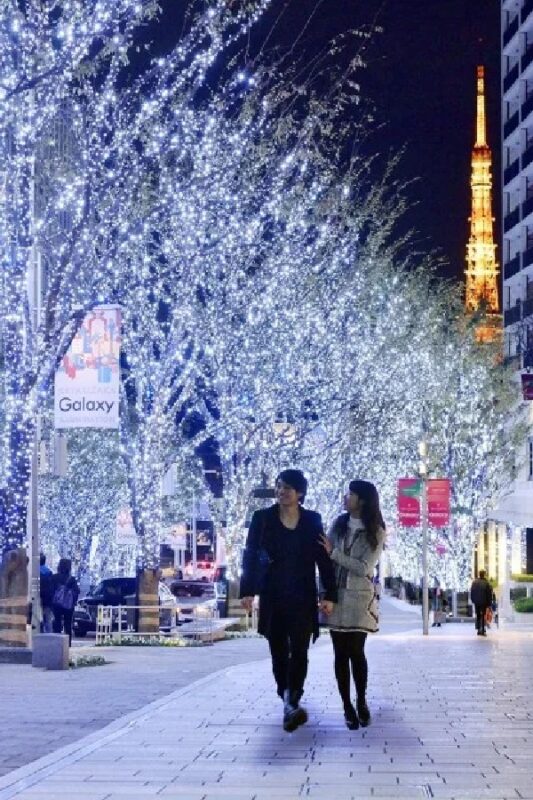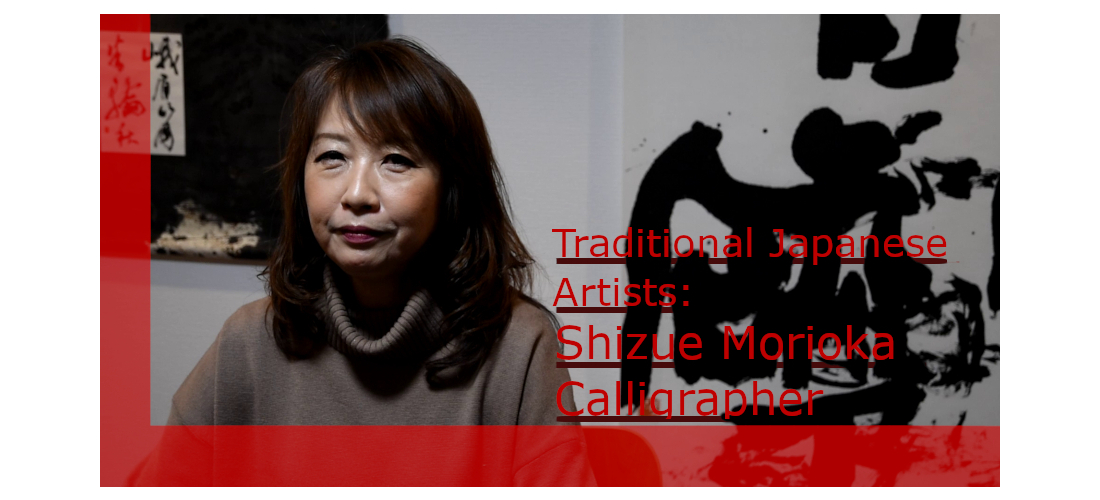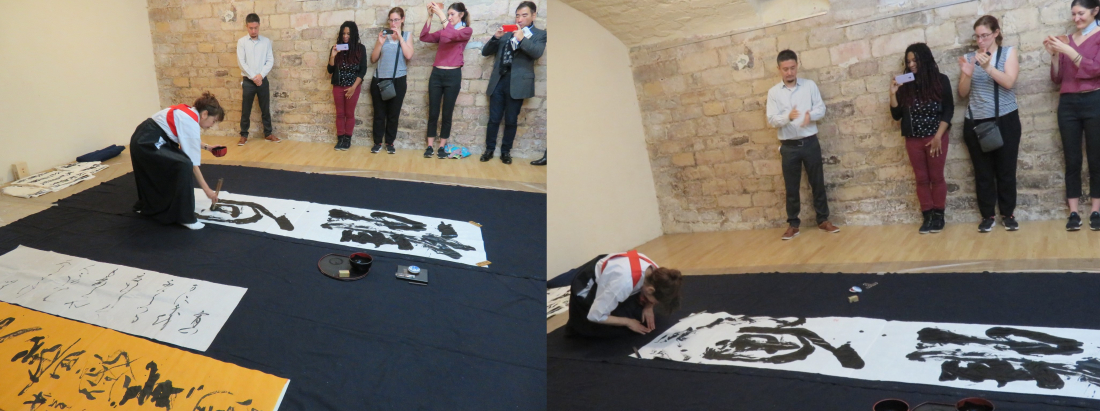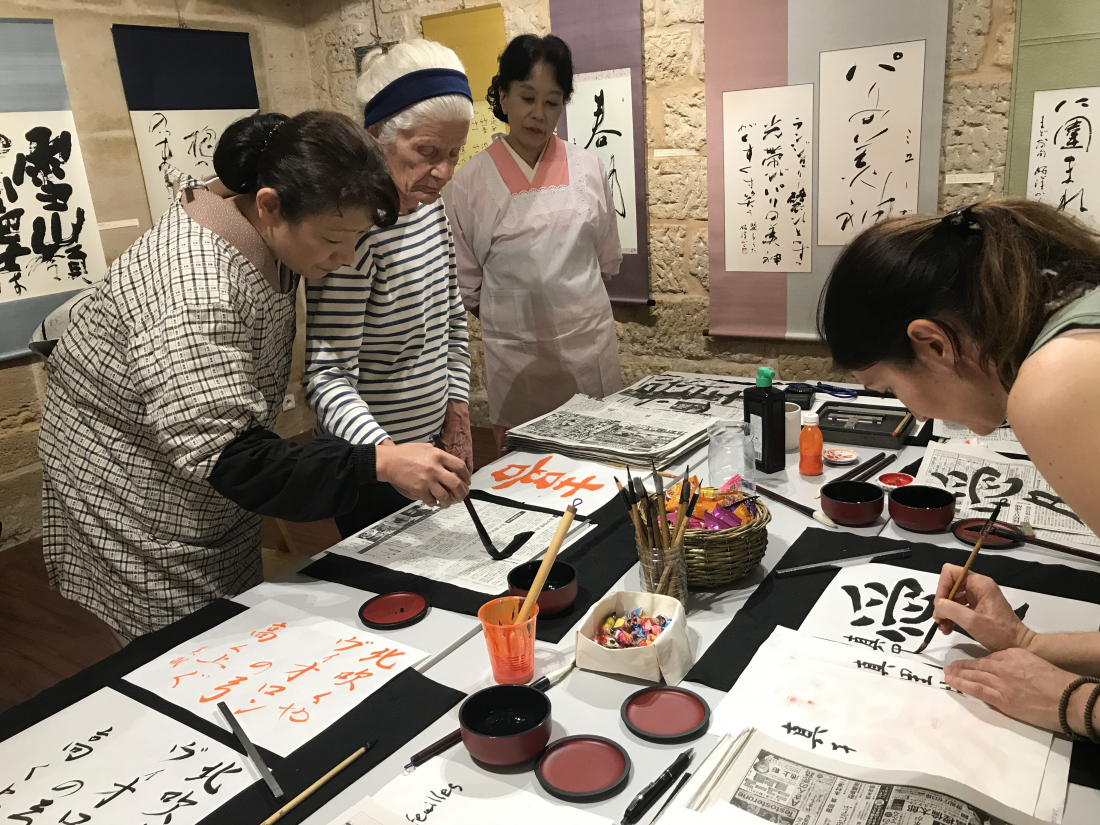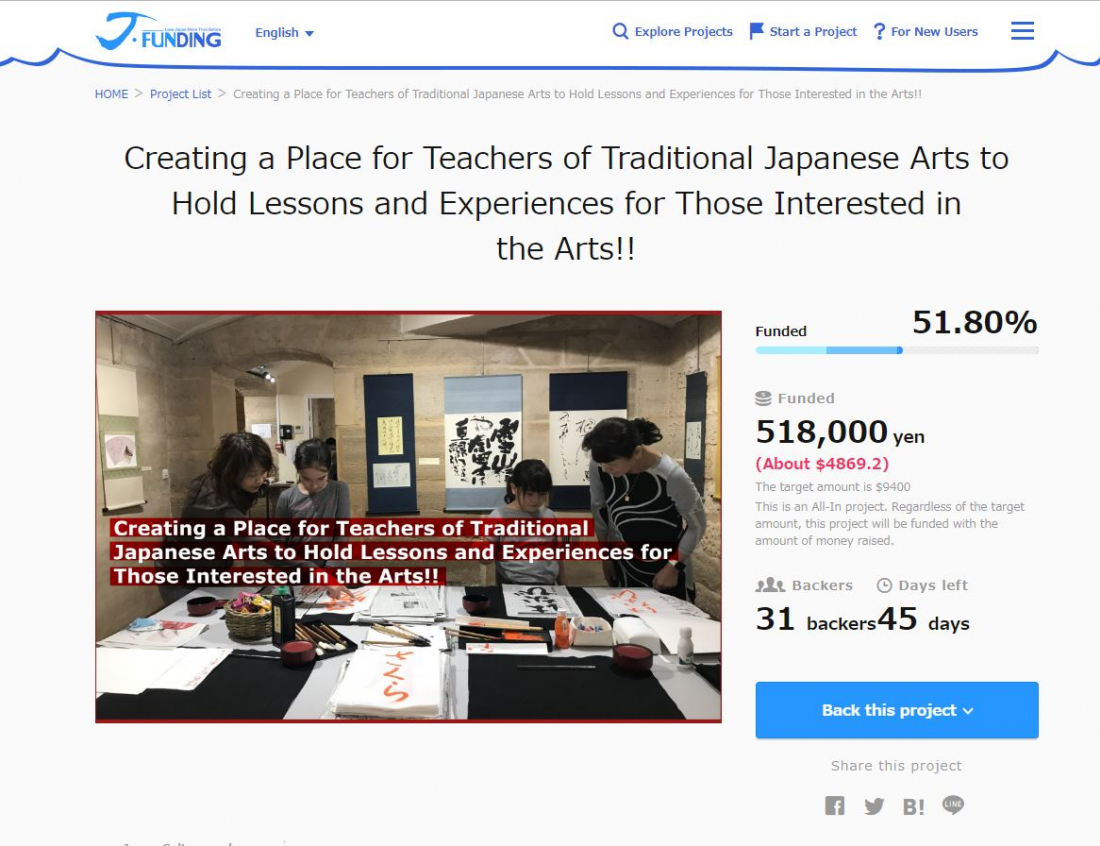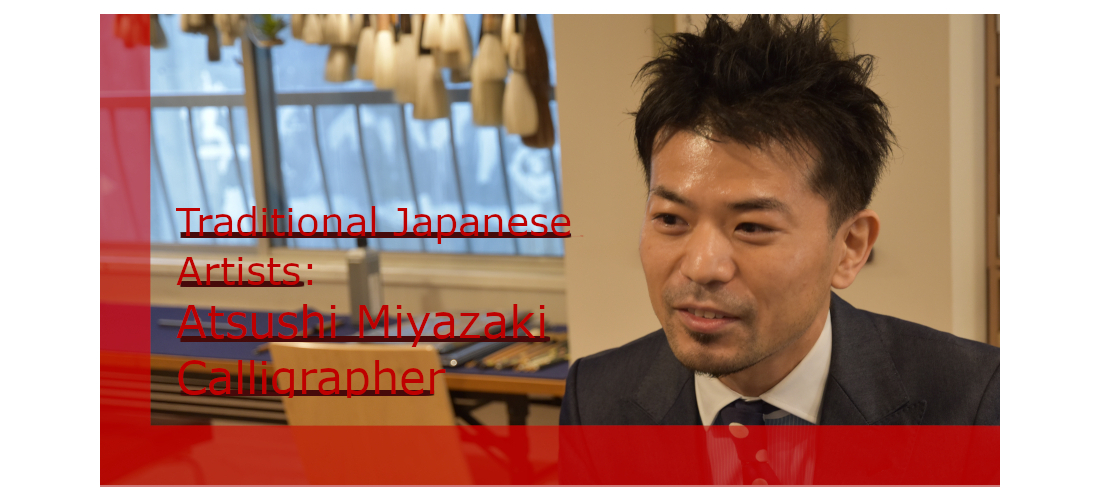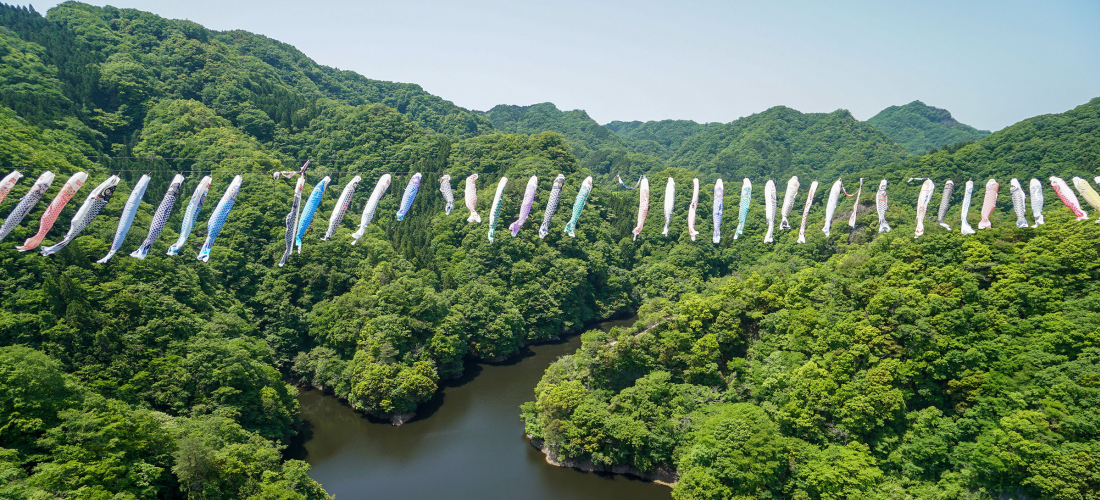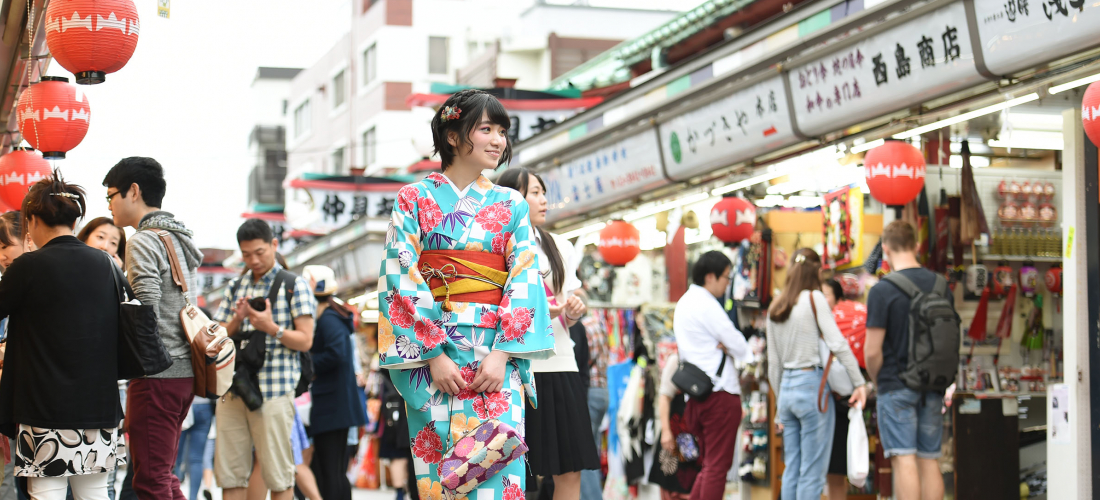CONTENTS
In this series we want to take a look at some amazing traditional Japanese artists, this time looking at Shodoka (書道家) or Japanese Calligrapher, Shizue Morikoa (森岡 静江). By doing so, we hope to interview some interesting and talented artists, so that you can find out more about wonderful traditional Japanese arts.
A quick background on Shodō
The practice of Japanese Calligraphy or Shodō (書道) has been around for over 1,500 years, dating back to when Chinese characters or Kanji was introduced to Japan. Examples can be found dating back to around 686 AD. Over the years the way of writing has changed, with a variety of styles occurring. There are three main styles that are in use today:
"Kaisho"楷書(かいしょ): A style where the artist deliberately makes each stroke recognisable, and is easiest to read. This would be seen as being closest to printed text.
"Gyosho"行書(ぎょうしょ): A style where strokes are less deliberately made. This is seen as being one of the most common forms of Shodō and the foundation for many schools of calligraphy in Japan.
"Sosho"草書(そうしょ): A style that is highly stylised and is made normally with the artist's brush rarely leaving the page. Due to being highly stylised, without mastering the art, it can be nigh impossible to read. This is seen as being the main style for artists to shine in.
Previous Interviews
Previously in this series we held an interview with Atsushi Miyazaki, who told us about his own experiences with the beautiful art that is Shodō! You can find his interview here!
A Look at Shizue Morioka
Q: How did you start learning Japanese Calligraphy?
A: I started shodo when I was young. Back then, everyone around me would go to learn shodo, this was around elementary school age. From then, we all went and enjoyed ourselves while learning shodo.
Q: Why did you carry on learning and then teaching?
A: When asked why I've carried on all these years, I don't have a real answer. It's more the fact that I just haven't stopped and it's become a part of me now. If I was to stop now, the person that is Shizue Morioka would cease to exist.
When it came to other people, they had their reasons to stop, but I didn't. I just liked to do it. Then when it came to thinking about my future, I felt that my only skill was in Shodo, so I wanted to be able to use that in the future.
Q: What does Shodo mean to you?
A: When it comes to what Shodo means to me, I think the most appropriate answer is Self Expression. For say muscians, music is their way to express themselves, for many people they have their own tools to express themselves, but for me, Shodo is the way I can full express myself.
A: I think when it comes to Shodo, it is a special type of art. It can be quite a spiritual process. Of course other arts have this as well, but when it comes to Shodo, no matter how many times you try, it is impossible to draw the same kanji exactly the same. I think that this is one of the most important parts of Shodo. With this, the parts of you that feels sad, or feels lonely, or feels happy are able to come out and it can be an amazing experience. It doesn't matter whether you are good at drawing or bad, its what happens in the moment that matters.
Q: Why do you want foreigners to learn about Shodo?
A: When it comes to having foreigners learning about Shodo, I've been lucky enough to have exhibitions overseas. One of the biggest take aways from this has been all those that have come into contact with it has been extremely respectful of it. As well as this, Japonism was seen quite a lot in the West in the past, and I would like to see another resurgence of this Japonism in the future!
Q: Why should foreigners learn about Shodo?
A: When it comes to Japanese Calligraphy, I think it is an art of the heart. What I mean by that is that more than other forms of art, you are able to pour your spirit and passion into this form of art more than other forms. It also has a complete sense of uniqueness, no matter how many people try to draw the same character, it's impossible to recreate the same character in the same way. This is not just because the way the brush falls on the paper, but how you put your feelings in to it as well, changing the character with each stroke. I think this is why foreigners could benefit a lot from experiencing or learning Japanese Calligraphy.
Q: What merits does this project have for foreigners?
A: I think until with this project and workshop, there hasn't been anything like it before, and you can enjoy a part of the art world like never before. I think this will be a great turning point to bring Japanese art to the rest of the world.
Q: What is the difference between teaching foreigners and Japanese people?
A: When it comes to Japanese people, they come to become better at making beautiful characters, but when it comes to foreigners, they wish to learn more about making art, as they don't normally have the language knowledge behind the characters.
Q: Why should foreigners learn about other traditional arts other than Shodo?
A: Japan has an amazing amount traditional types of art not just shodo, such as Sado( Tea Ceremony) or Kado (Flower Arranging). If foreigners are able to learn about these traditional arts, and us Japanese people are able to learn about their traditional culture, it will lead to a better understanding of each other and bring us closer.
Crowdfunding to raise money for a workshop for professionals to gather and teach foreigners
Currently Japan Culture and Technology, Inc (J-CAT) are raising money to create a workshop space for talented Shodō professionals to be able to teach foreigners that come in to Japan and wish to learn from a true professional!
You can find the project at the following link:
https://en.japankurufunding.com/projects/culture-workshop/
A variety of returns have been prepared for example workshop experiences as well as the chance to get your own custom piece of art from a professional Shoka!
We hope you can have a look at this project and support it!
Hey everyone! We hope that we can help you keep up to date with all the projects and things we have going on over at Japankuru Funding! We hope that you find the projects on the site as interesting as we do!
COMMENT
FEATURED MEDIA
VIEW MORE 
A New Tokyo Animal Destination: Relax & Learn About the World’s Animals in Japan
#pr #japankuru #anitouch #anitouchtokyodome #capybara #capybaracafe #animalcafe #tokyotrip #japantrip #카피바라 #애니터치 #아이와가볼만한곳 #도쿄여행 #가족여행 #東京旅遊 #東京親子景點 #日本動物互動體驗 #水豚泡澡 #東京巨蛋城 #เที่ยวญี่ปุ่น2025 #ที่เที่ยวครอบครัว #สวนสัตว์ในร่ม #TokyoDomeCity #anitouchtokyodome

Shohei Ohtani Collab Developed Products & Other Japanese Drugstore Recommendations From Kowa
#pr #japankuru
#kowa #syncronkowa #japanshopping #preworkout #postworkout #tokyoshopping #japantrip #일본쇼핑 #일본이온음료 #오타니 #오타니쇼헤이 #코와 #興和 #日本必買 #日本旅遊 #運動補充能量 #運動飲品 #ช้อปปิ้งญี่ปุ่น #เครื่องดื่มออกกำลังกาย #นักกีฬา #ผลิตภัณฑ์ญี่ปุ่น #อาหารเสริมญี่ปุ่น

도쿄 근교 당일치기 여행 추천! 작은 에도라 불리는 ‘가와고에’
세이부 ‘가와고에 패스(디지털)’ 하나면 편리하게 이동 + 가성비까지 완벽하게! 필름카메라 감성 가득한 레트로 거리 길거리 먹방부터 귀여움 끝판왕 핫플&포토 스폿까지 총집합!
Looking for day trips from Tokyo? Try Kawagoe, AKA Little Edo!
Use the SEIBU KAWAGOE PASS (Digital) for easy, affordable transportation!
Check out the historic streets of Kawagoe for some great street food and plenty of picturesque retro photo ops.
#pr #japankuru #도쿄근교여행 #가와고에 #가와고에패스 #세이부패스 #기모노체험 #가와고에여행 #도쿄여행코스 #도쿄근교당일치기 #세이부가와고에패스
#tokyotrip #kawagoe #tokyodaytrip #seibukawagoepass #kimono #japantrip

Hirakata Park, Osaka: Enjoy the Classic Japanese Theme Park Experience!
#pr #japankuru #hirakatapark #amusementpark #japantrip #osakatrip #familytrip #rollercoaster #retrôvibes #枚方公園 #大阪旅遊 #關西私房景點 #日本親子旅行 #日本遊樂園 #木造雲霄飛車 #히라카타파크 #สวนสนุกฮิราคาตะพาร์ค

🍵Love Matcha? Upgrade Your Matcha Experience With Tsujiri!
・160년 전통 일본 말차 브랜드 츠지리에서 말차 덕후들이 픽한 인기템만 골라봤어요
・抹茶控的天堂!甜點、餅乾、飲品一次滿足,連伴手禮都幫你列好清單了
・ส่องมัทฉะสุดฮิต พร้อมพาเที่ยวร้านดังในอุจิ เกียวโต
#pr #japankuru #matcha #matchalover #uji #kyoto #japantrip #ujimatcha #matchalatte #matchasweets #tsujiri #말차 #말차덕후 #츠지리 #교토여행 #말차라떼 #辻利抹茶 #抹茶控 #日本抹茶 #宇治 #宇治抹茶 #日本伴手禮 #抹茶拿鐵 #抹茶甜點 #มัทฉะ #ของฝากญี่ปุ่น #ชาเขียวญี่ปุ่น #ซึจิริ #เกียวโต

・What Is Nenaito? And How Does This Sleep Care Supplement Work?
・你的睡眠保健品——認識「睡眠茶氨酸錠」
・수면 케어 서플리먼트 ‘네나이토’란?
・ผลิตภัณฑ์เสริมอาหารดูแลการนอน “Nenaito(ネナイト)” คืออะไร?
#pr #japankuru #sleepcare #japanshopping #nenaito #sleepsupplement #asahi #睡眠茶氨酸錠 #睡眠保健 #朝日 #l茶胺酸 #日本藥妝 #日本必買 #일본쇼핑 #수면 #건강하자 #네나이토 #일본영양제 #อาหารเสริมญี่ปุ่น #ช้อปปิ้งญี่ปุ่น #ร้านขายยาญี่ปุ่น #ดูแลตัวเองก่อนนอน #อาซาฮิ

Japanese Drugstore Must-Buys! Essential Items from Hisamitsu® Pharmaceutical
#PR #japankuru #hisamitsu #salonpas #feitas #hisamitsupharmaceutical #japanshopping #tokyoshopping #traveltips #japanhaul #japantrip #japantravel

Whether you grew up with Dragon Ball or you just fell in love with Dragon Ball DAIMA, you'll like the newest JINS collab. Shop this limited-edition Dragon Ball accessory collection to find some of the best Dragon Ball merchandise in Japan!
>> Find out more at Japankuru.com! (link in bio)
#japankuru #dragonball #dragonballdaima #animecollab #japanshopping #jins #japaneseglasses #japantravel #animemerch #pr

This month, Japankuru teamed up with @official_korekoko to invite three influencers (originally from Thailand, China, and Taiwan) on a trip to Yokohama. Check out the article (in Chinese) on Japankuru.com for all of their travel tips and photography hints - and look forward to more cool collaborations coming soon!
【橫濱夜散策 x 教你怎麼拍出網美照 📸✨】
每次來日本玩,是不是都會先找旅日網紅的推薦清單?
這次,我們邀請擁有日本豐富旅遊經驗的🇹🇭泰國、🇨🇳中國、🇹🇼台灣網紅,帶你走進夜晚的橫濱!從玩樂路線到拍照技巧,教你怎麼拍出最美的夜景照。那些熟悉的景點,換個視角說不定會有新發現~快跟他們一起出發吧!
#japankuru #橫濱紅磚倉庫 #汽車道 #中華街 #yokohama #japankuru #橫濱紅磚倉庫 #汽車道 #中華街 #yokohama #yokohamaredbrickwarehouse #yokohamachinatown

If you’re a fan of Vivienne Westwood's Japanese designs, and you’re looking forward to shopping in Harajuku this summer, we’ve got important news for you. Vivienne Westwood RED LABEL Laforet Harajuku is now closed for renovations - but the grand reopening is scheduled for July!
>> Find out more at Japankuru.com! (link in bio)
#japankuru #viviennewestwood #harajuku #omotesando #viviennewestwoodredlabel #viviennewestwoodjapan #비비안웨스트우드 #오모테산도 #하라주쿠 #日本購物 #薇薇安魏斯伍德 #日本時尚 #原宿 #表參道 #japantrip #japanshopping #pr

Ready to see TeamLab in Kyoto!? At TeamLab Biovortex Kyoto, the collective is taking their acclaimed immersive art and bringing it to Japan's ancient capital. We can't wait to see it for ourselves this autumn!
>> Find out more at Japankuru.com! (link in bio)
#japankuru #teamlab #teamlabbiovortex #kyoto #kyototrip #japantravel #artnews
Photos courtesy of teamLab, Exhibition view of teamLab Biovortex Kyoto, 2025, Kyoto ® teamLab, courtesy Pace Gallery

Japanese Makeup Shopping • A Trip to Kamakura & Enoshima With Canmake’s Cool-Toned Summer Makeup
#pr #canmake #enoshima #enoden #에노시마 #캔메이크 #japanesemakeup #japanesecosmetics

⚔️The Robot Restaurant is gone, but the Samurai Restaurant is here to take its place. Check it out, and don't forget your coupon!
🍣신주쿠의 명소 로봇 레스토랑이 사무라이 레스토랑으로 부활! 절찬 쿠폰 발급중
💃18歲以上才能入場的歌舞秀,和你想的不一樣!拿好優惠券去看看~
#tokyo #shinjuku #samurairestaurant #robotrestaurant #tokyotrip #도쿄여행 #신주쿠 #사무라이레스토랑 #이색체험 #할인이벤트 #歌舞伎町 #東京景點 #武士餐廳 #日本表演 #日本文化體驗 #japankuru #japantrip #japantravel #japanlovers #japan_of_insta

Japanese appliance & electronics shopping with our KOJIMA x BicCamera coupon!
用JAPANKURU的KOJIMA x BicCamera優惠券買這些正好❤️
코지마 x 빅 카메라 쿠폰으로 일본 가전 제품 쇼핑하기
#pr #japankuru #japanshopping #kojima #biccamera #japaneseskincare #yaman #dji #osmopocket3 #skincaredevice #日本購物 #美容儀 #相機 #雅萌 #日本家電 #일본여행 #면세 #여행꿀팁 #일본쇼핑리스트 #쿠폰 #일본쇼핑 #일본브랜드 #할인 #코지마 #빅카메라 #japankurucoupon
MAP OF JAPAN
SEARCH BY REGION

LATEST
VIEW MOREEVENT CALENDAR
VIEW MORE
